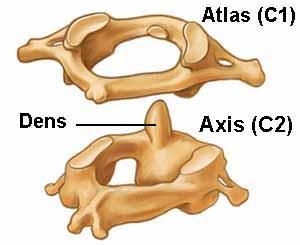When it comes to neck and back pain, many people immediately think about muscle strain, poor posture, or old injuries. While these are common causes, there’s another often-overlooked factor: axis spine alignment. The axis spine, specifically the second cervical vertebra (C2), plays a crucial role in the health of your neck and back. So, how does the axis spine affect pain in these areas, and what can be done to prevent or treat it? Let’s dive into this often misunderstood aspect of spinal health and explore the connection between axis spine alignment and neck and back pain.
What is the Axis Spine?
The axis is a crucial part of your cervical spine, located right at the top of your neck. It is the second cervical vertebra (C2), and it serves a key role in the rotation and movement of your head. The axis works in tandem with the first cervical vertebra, the atlas (C1), which holds your skull. Together, the atlas and axis allow for the range of motion needed for basic movements, like turning your head from side to side.
But what’s even more important is that the axis spine is located at the point where the spinal cord begins to branch out to the rest of your body. Misalignment at this crucial junction can lead to a variety of issues throughout your neck, back, and even down to your limbs.
The Connection Between Axis Spine and Neck Pain
When the axis spine becomes misaligned, it can have a domino effect on the rest of the cervical spine and surrounding structures. The misalignment of this critical vertebra may lead to nerve compression, muscle strain, and even headaches. Here’s how:
1. Nerve Compression and Irritation
The axis spine is closely connected to the spinal cord and the nerves that travel through it. A misaligned axis can cause compression or irritation of these nerves, leading to pain, numbness, and tingling sensations not just in the neck, but also in the arms and hands. This can make it difficult to perform simple tasks like holding a phone, typing, or even turning your head without discomfort.
2. Restricted Range of Motion
Misalignment in the axis can limit the movement of the neck, making it difficult to turn your head freely. This restriction in range of motion can lead to stiffness, discomfort, and further strain on the muscles in the neck and upper back. As a result, simple activities like driving, exercising, or even looking over your shoulder can become painful and difficult.
3. Muscle Imbalances
When the axis is out of alignment, the muscles around your neck, shoulders, and upper back may compensate for the misalignment. This can lead to muscle imbalances, where certain muscles become tight and overworked while others become weak or underused. These imbalances can cause chronic pain and discomfort, which can radiate into the back and shoulders.
4. Headaches
One of the most common side effects of axis misalignment is the onset of tension headaches or even migraines. Misalignment in the cervical spine, especially the axis, can trigger headaches by placing pressure on the muscles and nerves in the neck. In fact, many people who suffer from frequent headaches or migraines often find that correcting their neck alignment provides significant relief.
The Connection Between Axis Spine and Back Pain
While the axis is primarily located in the neck, its impact can extend far beyond just the cervical region. A misaligned axis can disrupt the overall alignment of your spine, affecting the entire back. Here's how:
1. Postural Problems
When the axis is misaligned, it can throw off the natural curvature of your spine, affecting your posture. For example, if the axis is rotated or tilted, your body may compensate by shifting your shoulders or pelvis, leading to poor posture. Poor posture increases strain on your back muscles and can lead to chronic back pain. This misalignment can also contribute to issues like spinal curvature, which can further exacerbate pain in the upper, middle, and lower back.
2. Spinal Stiffness and Degeneration
Misalignment of the axis can also affect the vertebrae in the lower back, leading to stiffness and discomfort. Over time, if left untreated, misalignment can contribute to the development of spinal conditions such as degenerative disc disease or herniated discs. These conditions can cause pain and numbness that radiates down the back and legs, severely limiting mobility and quality of life.
3. Altered Gait and Movement
The spine is a finely tuned structure, and when one part of it is misaligned, it can affect how the rest of the body moves. A misaligned axis can affect your gait, or the way you walk, putting additional strain on the muscles and joints in your back. This altered movement pattern can lead to pain and discomfort not just in the neck, but in the middle and lower back as well.
How to Address Axis Spine Misalignment
So, now that we know how important axis spine alignment is, how do you keep it in proper alignment and avoid neck and back pain? Here are some steps you can take to help prevent or treat misalignment and the associated pain:
1. Posture Correction
One of the most effective ways to maintain axis spine alignment is to work on improving your posture. Poor posture is one of the leading causes of misalignment, so paying attention to how you sit, stand, and sleep can make a big difference. Keep your head aligned with your spine, avoid slouching, and ensure that your workstation is ergonomically friendly.
2. Stretching and Strengthening Exercises
Engage in regular stretching and strengthening exercises to keep your neck and back muscles flexible and strong. Stretching helps reduce tightness, while strengthening exercises, particularly those targeting the core and upper back muscles, provide support to the spine and help maintain its alignment.
3. Chiropractic Care
Chiropractic care is a popular treatment option for addressing axis spine misalignment. Chiropractors specialize in spinal adjustments and can help correct misalignments in the neck and back, relieving pressure on the nerves and muscles. Regular chiropractic visits can ensure that your spine stays aligned and can provide relief from pain and discomfort.
4. Physical Therapy
If you’re dealing with significant neck or back pain due to axis misalignment, physical therapy can be a valuable treatment option. A physical therapist can guide you through exercises that help restore movement, strengthen supporting muscles, and alleviate pain. They may also provide techniques like massage therapy or traction to relieve tension in the neck and back.
5. Use Proper Sleep Support
Your sleep position can have a significant impact on your spinal alignment. Make sure to sleep on a pillow that supports the natural curve of your neck and choose a mattress that provides adequate support for your back. Sleeping in a position that keeps your spine aligned can help prevent further strain and misalignment.
Final Thoughts: The Importance of Axis Spine Alignment
When it comes to neck and back pain, the axis spine plays a far more significant role than most people realize. Misalignment in this crucial part of the cervical spine can lead to a cascade of issues, including pain, stiffness, poor posture, and even headaches. By focusing on proper posture, engaging in strengthening exercises, and seeking professional care like chiropractic adjustments or physical therapy, you can keep your axis spine in alignment and reduce the risk of pain.
Remember, the health of your spine affects your entire body. By addressing axis spine alignment, you’re not just preventing neck and back pain; you’re setting yourself up for better mobility, greater energy, and an improved quality of life. Don't wait for the pain to become unbearable—take action today to keep your spine aligned and your body feeling its best.



